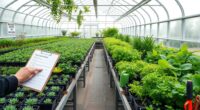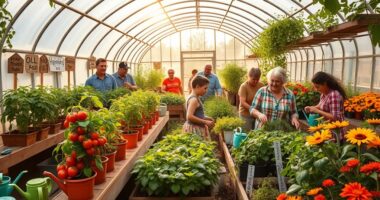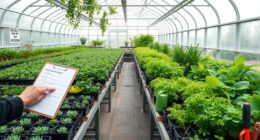Greenhouses are evolving with smart automation, vertical stacking, and climate control to boost efficiency and crop yields amid changing weather patterns. Sustainable practices like soil enrichment, drip irrigation, and rainwater harvesting help protect resources and strengthen resilience. Renewable energy sources like solar and wind power cut costs and emissions, supporting sustainable operations. Advances in crop selection and technology ensure food security in a shifting climate. To discover how these innovations shape our future food systems, explore further.
Key Takeaways
- Vertical farming and smart automation enable efficient, space-saving crop production resilient to climate variability.
- Renewable energy-powered greenhouses reduce carbon footprint and operational costs amid climate change.
- Advanced environmental monitoring ensures optimal conditions and early pest detection, enhancing crop resilience.
- Sustainable practices like soil enrichment and water conservation improve long-term greenhouse productivity.
- Innovations in crop genetics and climate-adapted varieties boost food security in changing climates.
Advancements in Greenhouse Technologies
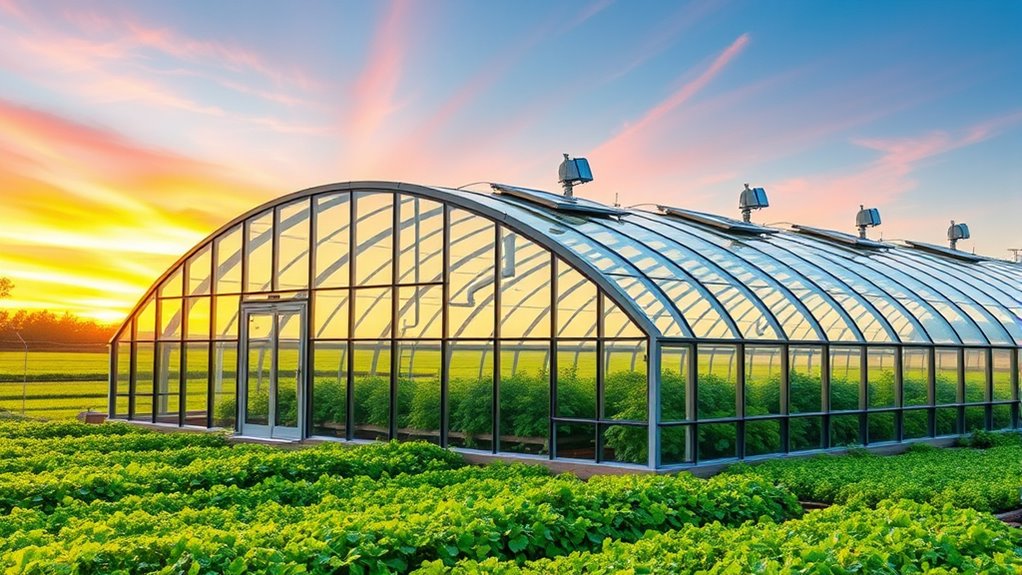
Advancements in greenhouse technologies are transforming how we grow food by making indoor farming more efficient and sustainable. One key innovation is vertical farming, which stacks crops in multi-level systems, maximizing space and productivity in limited areas.
Vertical farming enhances space efficiency and boosts productivity in indoor agriculture.
Paired with smart automation, these systems become highly efficient, reducing labor and resource waste. Sensors monitor temperature, humidity, and light levels in real-time, allowing precise control over growing conditions. Additionally, environmental monitoring systems enable early detection of issues such as pests or disease, improving crop health management.
Automated irrigation and nutrient delivery ensure plants get exactly what they need, minimizing water and fertilizer use. These technological improvements not only boost yields but also lower energy consumption and environmental impact. Moreover, integrating climate control systems helps maintain optimal conditions regardless of external weather fluctuations, further enhancing sustainability.
Implementing plant health monitoring systems further enhances crop management by detecting issues early and optimizing growth conditions. This integration can also support biodiversity by reducing the need for chemical inputs and promoting healthier ecosystems. Additionally, innovations in climate-resilient crops are helping farmers adapt to changing environmental conditions, ensuring food security. As a result, you can expect fresher produce, year-round availability, and a significant step forward in sustainable agriculture.
Sustainable Practices for Climate Resilience
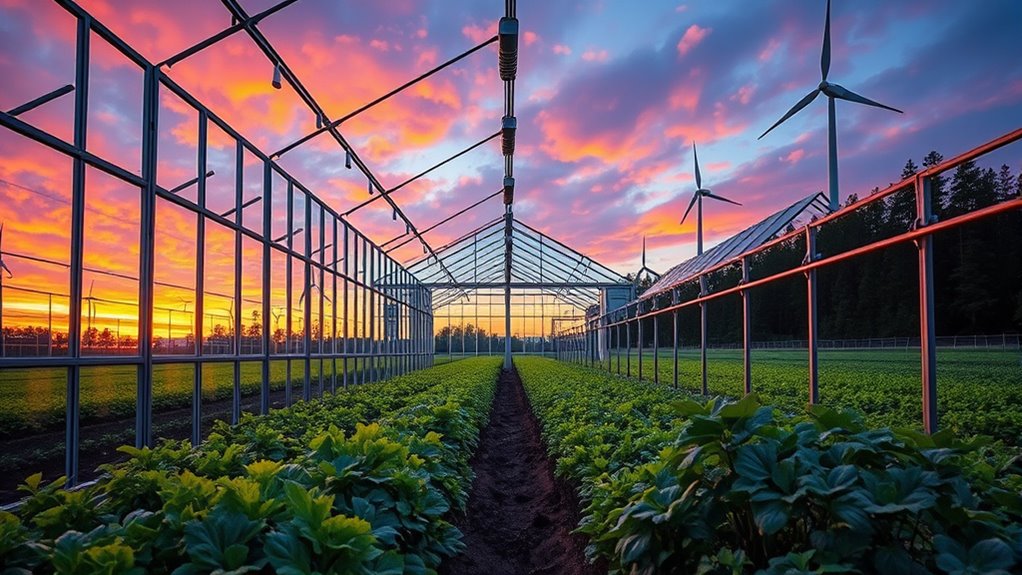
As climate change accelerates, adopting sustainable practices becomes indispensable to enhance agricultural resilience. You can improve soil health by adding organic matter, rotating crops, and reducing chemical use. Incorporating soil enrichment techniques can further promote healthy plant growth and soil stability. These methods also help mitigate the effects of soil degradation, which is increasingly linked to changing climate conditions. Water conservation is equally crucial; implementing drip irrigation and rainwater harvesting minimizes waste. These practices create a resilient greenhouse environment. Consider the following table to understand their impact:
| Practice | Benefit | Focus Area |
|---|---|---|
| Cover cropping | Prevents erosion, maintains soil | Soil health |
| Drip irrigation | Reduces water waste | Water conservation |
| Organic amendments | Boosts soil fertility | Soil health |
| Rainwater harvesting | Ensures water supply | Water conservation |
| Crop rotation | Breaks pest cycles, enriches soil | Soil health |
Implementing these strategies can also help address soil health issues exacerbated by climate change.
The Role of Renewable Energy in Greenhouse Operations

Renewable energy sources are transforming greenhouse operations by providing sustainable, cost-effective power solutions. You can harness solar integration to power lighting, ventilation, and irrigation systems, reducing reliance on grid electricity and lowering operational costs. Installing solar panels allows your greenhouse to generate clean energy during daylight hours, making your operations more resilient and eco-friendly. Wind power is another option, especially in areas with consistent wind patterns; small-scale turbines can supplement solar energy, ensuring a reliable power supply even on cloudy days or calm nights. By integrating these renewable sources, you enhance your greenhouse’s sustainability and reduce carbon emissions. Additionally, implementing energy storage solutions can further stabilize power supply and optimize energy use. Using renewable energy also minimizes your greenhouse’s environmental footprint, aligning with sustainable farming practices. This shift not only supports environmental goals but can also lead to long-term savings, making your operation more competitive and aligned with future climate-conscious practices. Incorporating renewable energy systems can also provide educational opportunities for your community and customers, highlighting your commitment to sustainability and climate resilience.
Innovations in Crop Selection and Management

Innovations in crop selection and management are reshaping how greenhouses optimize productivity and sustainability. You now have access to advanced techniques like vertical farming, which maximizes space and yields, and genetic modification, allowing crops to thrive in changing climates. A higher contrast ratio in greenhouse lighting systems can improve plant growth and health by providing better control over light quality and intensity. Additionally, celebrity lifestyle insights reveal how integrating aesthetic design with functional technology can enhance the overall environment of commercial and personal greenhouses. To make the most of these innovations, consider these key points:
- Vertical farming enables you to grow more crops in limited space, reducing land use.
- Genetic modification creates resilient plants better suited for fluctuating environmental conditions.
- Selecting climate-adapted crops improves yield stability.
- Integrated management systems enhance resource efficiency and crop health.
- Incorporating advanced lighting technology can further optimize plant development and energy use, especially when combined with precise environmental controls.
Furthermore, understanding specialized equipment like climate control systems can significantly enhance the efficacy of these innovations.
Challenges and Opportunities for Global Food Security

How can we address the complex challenges threatening global food security? One way is by expanding urban farming, which brings fresh produce closer to consumers, reduces transportation emissions, and maximizes limited space. However, tackling food waste is equally essential; nearly a third of all food produced goes uneaten, wasting resources and deepening food insecurity. Implementing security zone systems in food infrastructure could help safeguard supply chains against disruptions. By improving supply chain efficiency and consumer habits, we can cut waste considerably. These strategies present opportunities to increase food availability without straining ecosystems. Embracing innovative solutions like vertical farms and community gardens can bolster local resilience.
Ultimately, integrating urban farming and reducing food waste helps create a more sustainable, accessible food system that can withstand climate impacts and feeding a growing global population.
Frequently Asked Questions
How Will Urban Greenhouses Impact Local Biodiversity?
Urban greenhouses can positively impact local biodiversity through thoughtful greenhouse integration. As you incorporate greenhouses into city landscapes, you create habitats that support native species and attract pollinators, boosting urban biodiversity.
However, if not carefully managed, they might also introduce invasive species or disrupt existing ecosystems. By prioritizing native plants and sustainable practices, you guarantee greenhouses enhance urban biodiversity rather than harm it.
What Policies Support Greenhouse Adoption in Developing Countries?
You might think adopting greenhouses is too costly, but policies like tax incentives and subsidies make it easier. Developing countries benefit from international collaborations that share technology and expertise, reducing barriers.
Supportive policies foster local innovation and sustainable growth. These initiatives help farmers increase yields, adapt to climate change, and improve food security, proving that strategic policies and global partnerships are essential for greenhouse adoption in developing nations.
Can Greenhouses Adapt to Extreme Weather Events Effectively?
You can enhance climate resilience in agriculture by using greenhouses that adapt to extreme weather events. With technological innovations like climate-controlled systems and durable materials, greenhouses can protect crops from storms, droughts, and temperature fluctuations.
These advancements allow you to maintain stable food production despite climate challenges, making greenhouses an essential tool in building a resilient food system that withstands the impacts of extreme weather.
How Does Consumer Behavior Influence Greenhouse-Grown Food Markets?
Your choices shape the greenhouse-grown food markets more than you realize—your preferences and purchasing trends hold the power to revolutionize agriculture.
When you prioritize organic, locally-sourced, or sustainable options, you drive demand and influence farmers’ practices.
What Are the Long-Term Economic Impacts of Greenhouses on Agriculture?
You see, the long-term economic impacts of greenhouses on agriculture promote economic sustainability and market stability. Greenhouses allow you to grow crops year-round, reducing reliance on seasonal weather and increasing productivity.
This stability attracts investments and supports farmers’ income. Over time, greenhouses help you manage costs more effectively, ensuring a resilient agricultural sector that can adapt to changing climate conditions while maintaining steady food supplies and economic growth.
Conclusion
As you look ahead, the future of food hinges on these green innovations. Greenhouses will transform how you grow crops, blending technology with sustainability. But challenges remain—will these solutions be enough to feed a changing world? The next breakthrough could be just around the corner, shaping a resilient food system. Stay tuned, because what unfolds could redefine your relationship with food and the climate—if you’re ready to embrace the change.

